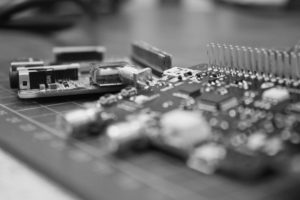Whether we are aware of it or not, the so-called “Internet of Things” (IoT) has long since found its way into our everyday lives: via sensors in vehicles, machines, household appliances and buildings. All such devices can be connected to the internet and facilitate communication between people, processes and things. Agriculture is also taking advantage of this technology in order to ensure more efficient production.

What is the IoT?
The term “Internet of Things” (IoT) was first coined in 1999 by the British technology pioneer Kevin Ashton. It describes a network that enables uniquely identifiable objects (Things) to be connected via the internet. In other words, internet-based networks between real objects are established in order to exchange information. This exchange of information can take place with humans as well as between machines (M2M). Such networking allows devices to send and receive data and also, often, to act independently.
Technology
Each intelligent object in the Internet of Things can be identified via a unique internet address. Its connection to the internet can be wired or wireless. Wireless networking, which has many advantages, can be broken down into wide area and short-range networks. Transmission technologies for short-range networks include WLAN, Bluetooth and Zigbee. These operate over short distances at high data rates and are predominantly used in home automation and for various medical applications. Connectivity for wide area networks (WAN) is mostly provided by mobile communications companies on the basis of GSM, GPRS, UMTS and LTE standards. These are used when either large data volumes must be sent or received or energy consumption is not a major concern. However, as there is often no energy supply infrastructure in the locations where data is being collected, many devices have to be operated using rechargeable batteries. In such cases, low power wide area networks (LPWAN) are used, with transmissions being facilitated by cellular companies using the Narrowband Internet of Things (NB-IoT) or via Sigfox or LoRaWAN. Sigfox is a French telecommunications company that is building its own global wireless network, which will wirelessly connect low-power objects to the internet. Similarly, LoRaWAN (Long Range Wide Area Network) is a low-energy networking protocol that allows one to build one’s own networks. These technologies are designed to optimise energy efficiency (long life, no need to swap batteries), data rate (the volume of information required) and range (deep building penetration). Such sensors can be in use for up to 10 years before batteries have to be replaced.
Applications of the Internet of Things
In the private sector, IoT devices are proliferating rapidly in such forms as fitness wristbands that measure the pulse and count steps, pet trackers that enable the real-time tracking of dogs or cats and “smart home” applications.
In the corporate sector, examples of the use of the IoT include the networking of both products and business processes. IoT services and functions can be integrated into products and these generate data that can be used to make companies more efficient.
The slogan “Industry 4.0” is no less than the proclamation of a fourth industrial revolution, which is already in full swing. Its goal is to replace all analogue processes with digital ones and to promote self-organised production in which machines, systems, products and people communicate and cooperate with each other.
IoT in agriculture
A wide range of scenarios for the use of IoT sensors is also conceivable in agriculture, from self-driving tractors and networked harvesting machines to systems for monitoring weather and irrigation. The technology is also highly suitable for the automation of greenhouses and the management of livestock. The term “precision farming” also covers a number of processes based on the linking and interpretation of aggregated data. This phenomenon is exemplified by the weather stations of RWA Raiffeisen Ware Austria, which only achieve their full potential when networked with each other. Due to their high level of configurability, these stations can be optimally adapted to individual needs. For example, calculations of the risk of a certain plant disease becoming established in the field can be made for more than 80 plant diseases and 40 crops, and this information can support decision-making regarding needs-based crop protection. Due to climate change, the targeted use of water resources will become increasingly important and data from IoT sensors, in combination with weather forecasts, can also provide valuable insights in this area. These new sensors are also finding their way into not only arable fields but also pastures and stables. In the interests of animal welfare it is essential that livestock producers improve their current practices. The early detection of climate-related stress factors will enable farmers to respond quickly to even the slightest changes in animal behaviour and, hence, to counter any adverse effects.
Another example of the use of IoT that is already being used by the RWA subsidiary Wärme Austria is OilFox. OilFox is an innovative ultrasonic level metre for heating oil tanks that is connected to the internet via WLAN or NB-IoT. Hence, real-time oil levels can be conveniently checked via the OilFox app and analogue monitoring is no longer necessary.
Such solutions will contribute significantly to making agriculture smarter, more connected and, thus, more efficient. RWA’s cooperation with Magenta, which ensures that a comprehensive and future-proof network is available for the use of IoT devices in the Lagerhaus network, means that the company is well prepared for the challenges of the future.
We are currently working intensively on identifying new technological developments and developing possible scenarios for their application. The areas being addressed in our latest projects include tracked transport boxes, sensor technology in warehouses and data collection in silos and flat stores.
